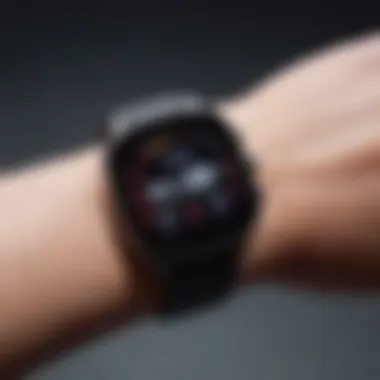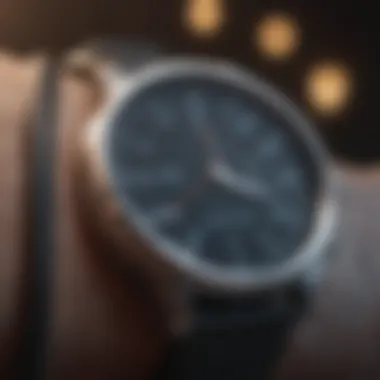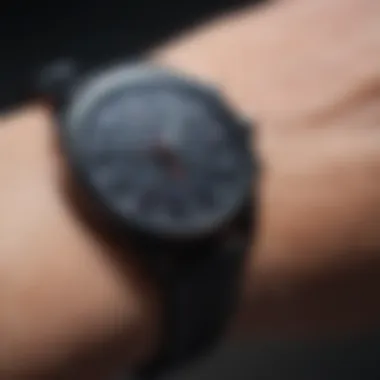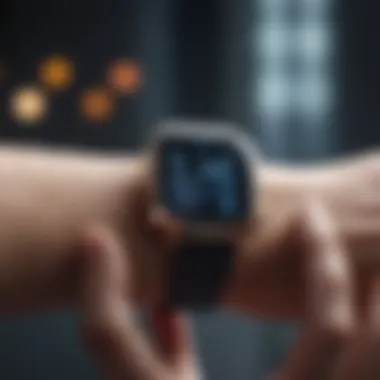Can a Watch Accurately Track Blood Pressure?


Intro
The integration of technology into health monitoring has transformed how individuals track various physiological metrics. One area that has garnered significant attention is the ability of smartwatches to track blood pressure. This is particularly relevant as hypertension remains a leading health issue worldwide, affecting millions. Smartwatches, ranging from the Apple Watch to Samsung Galaxy Watch, have evolved to include features that may help users monitor their blood pressure outside traditional medical environments.
Understanding whether these devices can provide accurate readings and how they operate is essential for anyone considering the use of a smartwatch as a health tool.
Research Highlights
Key Findings
Recent studies and consumer reviews suggest that smartwatches can measure blood pressure with varying degrees of accuracy. Most of these devices utilize photoplethysmography (PPG) and oscillometric methods to estimate blood pressure. PPG, which measures blood volume changes in the microvascular bed of tissue, combined with algorithms, allows for indirect readings.
However, it's crucial to note that while some models offer promising results, they often do not match the precision of sphygmomanometers used in clinical settings. Research indicates that certain brands, like Garmin and Fitbit, have models that can provide adequate data for personal monitoring, but the reliability can fluctuate based on user techniques and health conditions.
Implications and Applications
The implications of tracking blood pressure with smartwatches reach beyond personal convenience. For patients with chronic conditions, continuous monitoring can provide essential insights into their health status. It can alert users to potential health risks, facilitating timely medical consultations. Overall, the accessibility of these tools has the potential to empower users to take ownership of their health.
Methodology Overview
Research Design
The investigation into smartwatch blood pressure tracking capabilities often involves longitudinal studies where users wear devices over extended periods. These studies compare smartwatch readings against established medical devices, aiming to present a clearer picture of their effectiveness in varied populations.
Experimental Procedures
In many experiments, volunteers are subjected to controlled blood pressure readings while wearing their smartwatches. The readings are recorded and analyzed to evaluate the correlation between smartwatch measurements and traditional devices. Factors such as user movement, device positioning, and skin temperature are also considered, as they can significantly affect the results.
Finale
As smartwatches continue to evolve, their role in health monitoring will likely expand. While they may not entirely replace traditional methods, their capacity to contribute to personal health data collection is undeniable. Future advancements will likely enhance their accuracy, making them more viable options for tracking critical health metrics like blood pressure.
"The convenience of having health data at one's fingertips can lead to a proactive approach to personal wellness."
In summary, while there are still limitations, the progress in smartwatch technology reflects a noteworthy step towards integrating real-time health monitoring into everyday life.
For further reading on related technologies and their applications, consider visiting resources like Wikipedia, Britannica, Reddit, and Facebook.
Preamble to Blood Pressure Monitoring
Blood pressure monitoring is critical for maintaining overall health and well-being. Uncontrolled blood pressure can lead to serious health issues, including heart disease and stroke. With the rise of chronic conditions, understanding blood pressure and its implications has become more important than ever. Health professionals emphasize regular monitoring to help individuals manage their cardiovascular health more effectively. This article discusses the place of smartwatches in this sphere, especially regarding their ability to measure blood pressure.
Importance of Blood Pressure Management
Managing blood pressure is essential for preventing long-term health complications. The Centers for Disease Control and Prevention (CDC) indicates that nearly half of adults in the United States have hypertension. Regular monitoring allows individuals to detect irregularities in their blood pressure early on. Detecting these issues can facilitate timely intervention, which is crucial in preventing larger health problems.
Furthermore, understanding one’s blood pressure can promote healthier lifestyle choices. Patients can adapt their diets, exercise routines, and medications based on their monitoring results. Tracking blood pressure can also help reinforce positive behavior changes, as people are likely to stick to their health goals when they see measurable outcomes.
Traditional Methods of Measurement
Traditionally, blood pressure is measured using a sphygmomanometer. This device consists of an inflatable cuff that is wrapped around the upper arm, along with a measuring device. The process usually requires a healthcare professional. The two main readings taken during this measurement are systolic and diastolic pressure.
While manual measurement is effective, it has limitations. It often requires patients to visit clinics, which may not be convenient. Some people may feel anxious in clinical settings, leading to artificially high readings, a phenomenon known as white coat syndrome. Moreover, regular visits can be costly and time-consuming. With the advent of technology, there is a growing trend towards more accessible and frequent monitoring methods, including digital and wearable devices.
In summary, blood pressure monitoring is crucial for health management. The traditional methods of measurement have served us well, but as technology advances, alternative methods, including smartwatches, are becoming more common.
Overview of Smartwatch Technology
Smartwatch technology has evolved significantly in recent years. The introduction of health tracking features has fundamentally altered how individuals monitor their well-being. In this context, understanding the role of smartwatches, particularly in relation to blood pressure monitoring, is crucial. This section aims to delve deeper into the foundational developments that have made such capabilities possible, highlighting both their potential benefits and associated considerations.


Development of Health Tracking Features
The development of health tracking features within smartwatches is driven largely by advancements in sensor technologies and user demand for health monitoring tools. Increasing awareness of health issues, like hypertension, has led to rising interest in devices that can provide real-time feedback. Smartwatches now often include functionalities such as heart rate monitoring, step counting, and, more recently, blood pressure tracking.
Many companies, such as Fitbit and Garmin, have recognized this trend and developed rich ecosystems of applications. These applications aim to assess various health metrics, combining data processing with user engagement. The infusion of artificial intelligence has started to play a role in enhancing the capabilities of these devices, allowing for more accurate tracking.
Adopting these tools can lead to better health management for users. They enable individuals to gather substantial information regarding their cardiovascular health. However, it is also important to consider potential drawbacks, including data privacy and reliance on technology for vital health indicators.
Sensors Used in Smartwatches
Sensors are the heartbeat of smartwatch technology. They gather data that can then be analyzed and presented to the user. In the realm of blood pressure tracking, several sensor types have emerged. Optical sensors, which utilize photoplethysmography, are among the most common. PPG technology measures blood flow changes through the skin
These sensors offer a non-invasive way to track metrics. However, the accuracy of readings can be influenced by various factors, including skin tone, motion, and placement. Other methods, such as using a traditional cuff integrated into a smartwatch, provide a different approach but might compromise on convenience.
"The integration of advanced sensors is essential for the precision of health tracking in smartwatches."
In summary, the evolution of smartwatch technology, particularly in developing health tracking features, reflects broader trends in health monitoring. With sensors that can measure vital parameters, there is promise for smartwatches to offer significant insights into users' cardiovascular health. Nonetheless, understanding the limitations and contexts of these technologies aids users in making informed decisions.
Methodologies for Blood Pressure Tracking
The methodologies for tracking blood pressure are crucial in understanding how modern smartwatches can function as health-monitoring devices. As the prevalence of hypertension increases globally, innovative ways to monitor blood pressure continuously are essential. Tracking methodologies provide the means to capture data accurately and reliably. When evaluating wearables, it is important to consider how these methodologies can enhance user experience and health outcomes.
Optical Sensors and PPG Technology
Optical sensors, particularly through the use of Photoplethysmography (PPG), have become a cornerstone in modern health tracking. PPG technology measures blood volume changes in the microvascular bed of tissue. It does this by illuminating the skin and recording the amount of light that is absorbed or reflected. This method is non-invasive and can be performed swiftly.
Using optical sensors to measure blood pressure adds certain advantages:
- Continuous Monitoring: Users can collect data continuously without discomfort.
- Ease of Use: Most users find it easy to wear a watch rather than using a traditional cuff.
- Real-Time Analysis: Data can be processed immediately, allowing for quicker responses to potential health risks.
However, accuracy can be debated. While PPG can track trends in blood pressure, it may not always provide exact readings compared to traditional methods. The precision often depends on factors such as skin color, ambient light, and user’s movements during measurement. Despite these challenges, many manufacturers are working to improve algorithms to better interpret PPG data for more reliable outcomes.
Cuff-Based Techniques Integrated into Wearables
While optical sensors are gaining traction, cuff-based techniques are not to be overlooked. Some smartwatches integrate technology from traditional sphygmomanometers, enabling users to wrap a cuff around their wrist or arm. This method is familiar to many and considered a gold standard in blood pressure measurement.
The integration of cuff-based techniques into wearables offers various benefits:
- High Accuracy: Cuff-based measurements tend to be more accurate, especially in clinical contexts.
- Calibrated Systems: Devices can be calibrated to ensure readings are precise and reliable based on individual user physiology.
Despite the benefits, this approach might have drawbacks as well:
- User Compliance: Users may find it cumbersome to attach a cuff, leading to inconsistent monitoring.
- Accessibility Issues: Some users may struggle with tight cuffs or have limited mobility, impacting the practicality of this method.
"The ability to monitor blood pressure through wearables marks a significant step in personal health management."
In the next section, we will explore how to evaluate the accuracy and reliability of these methodologies.
Evaluating Accuracy and Reliability
Evaluating the accuracy and reliability of blood pressure measurements from smartwatches is crucial in understanding their role in personal health monitoring. As these devices become increasingly popular for tracking vital signs, establishing their effectiveness compared to traditional methods is necessary.
Accurate blood pressure readings are vital for managing health issues such as hypertension. If a smartwatch provides incorrect readings, it could mislead users regarding their health status. This can lead to either unnecessary panic or a false sense of security. Therefore, accuracy is essential when evaluating whether a smartwatch can be a dependable tool in measuring blood pressure.
Reliability also pertains to the consistency of the measurements. Users need to trust that the readings they receive are not just accurate at one moment but hold up over repeated use. Reliable data can help in making informed decisions and tracking long-term health trends.
As we delve deeper into this topic, we will focus on comparative studies with traditional equipment and the factors that can influence measurement accuracy.
Comparative Studies with Traditional Equipment


Several studies have investigated the accuracy of blood pressure measurements taken by smartwatches in comparison to traditional equipment, such as sphygmomanometers. These comparisons offer valuable insights into how well these wearables perform.
Research has shown mixed results. In some cases, smartwatches equipped with advanced sensors align closely with traditional measurements. However, other studies indicate discrepancies in readings, especially at extreme values of blood pressure.
Key points from these comparative studies include:
- Validation Standards: Many studies utilize specific standards to validate smartwatch measurements. These benchmarks help in determining the reliability of the devices.
- Population Diversity: Results can vary based on demographic factors such as age, gender, and overall health. Thus, a smartwatch’s effectiveness might differ among users.
- Environmental Influences: Factors like movement, body position, and even ambient temperature can affect readings.
Understanding these factors is essential, as it helps set realistic expectations about using smartwatches for blood pressure monitoring in real-world scenarios.
Factors Influencing Measurement Accuracy
Multiple factors can affect the accuracy of blood pressure readings on smartwatches. This understanding allows users to use these devices more effectively and interpret the results with caution.
Key factors include:
- Sensor Quality: The type and quality of sensors used in smartwatches directly impact their measurement accuracy. Devices with advanced optical sensors tend to perform better.
- Calibration: Regular calibration with traditional instruments ensures that smartwatches maintain an accurate reading over time. Calibration is often overlooked, yet it plays a pivotal role in reliability.
- User Technique: Proper usage of the device is essential. Factors such as how the watch is worn and whether the wearer is still during measurement can influence results.
- Physiological Variations: Individual differences, such as skin tone, body fat percentage, and hydration levels, can also lead to variations in readings.
Accurate blood pressure monitoring through smartwatches hinges on awareness of these influencing factors, as incorrect assumptions can lead to misinterpretation of one's health status.
Practical Applications of Blood Pressure Tracking
Blood pressure tracking through smartwatches represents a significant advancement in personal health management. The capability of these devices to provide continuous monitoring offers more than convenience; it empowers users with the information necessary to manage their health proactively. A practical understanding of how smartwatches can be utilized in blood pressure monitoring is essential for grasping their potential impact on public health.
Monitoring Hypertension and Related Conditions
Hypertension is often referred to as a silent killer due to its often asymptomatic nature. By utilizing a smartwatch for blood pressure tracking, users can regularly monitor their readings, helping them detect any concerning trends early on. Furthermore, this can lead to prompt intervention from healthcare providers, reducing the risk of more severe health problems such as heart disease or stroke.
Regular monitoring enables individuals to:
- Track their blood pressure trends over time.
- Share data with healthcare professionals for better-informed treatment decisions.
- Adjust lifestyle choices based on real-time data, such as diet and exercise.
Additionally, those with pre-existing conditions, such as diabetes or cardiovascular diseases, can benefit from constant monitoring. The integration of these devices into daily routines fosters a culture of awareness and encourages adherence to treatment plans.
User Experience and Engagement
The effectiveness of smartwatches in blood pressure tracking is not solely dependent on technology but also on user experience. A smooth interface, ease of data interpretation, and supportive features contribute to engagement, making it more likely for individuals to utilize these tools consistently.
Engagement can be enhanced by:
- Offering clear, understandable insights into the user’s blood pressure readings.
- Providing reminders for checks, especially during critical times like medication schedules.
- Enabling users to set personalized health goals, motivating them to adhere to lifestyle changes.
Moreover, social features, such as connecting with friends or participating in health challenges, can add a level of accountability, further improving user engagement with health tracking.
In summary, smartwatches serve as more than just time-telling devices; they are critical tools for monitoring hypertension and enhancing the user experience. By understanding these practical applications, individuals can better leverage these devices to manage their health effectively.
Limitations of Smartwatches in Health Monitoring
In the context of wearable technology, understanding the limitations of smartwatches in monitoring health, specifically blood pressure, is crucial. While these devices have advanced significantly and offer valuable insights, there are inherent challenges. Recognizing these limitations can guide users to set realistic expectations about the capabilities of smartwatches. Additionally, it emphasizes the need for ongoing research and development.
Technical Limitations
Smartwatches face several technical limitations in accurately measuring blood pressure. One significant challenge is the reliance on optical sensors and photoplethysmography (PPG) technology. PPG measures blood flow through the skin using light, but its accuracy can be influenced by various factors. For example, skin color, ambient light, and even the device’s placement can alter results. This inconsistency can lead to either false readings or an inability to obtain a reading altogether.
Another technical aspect involves the calibration of smartwatches. Unlike traditional sphygmomanometers, which are calibrated regularly against known standards, many smartwatches do not offer a straightforward method for calibration. This can raise questions about data reliability over time. Furthermore, certain smartwatches require the user to maintain a specific posture or even a still position during measurement, which can be impractical in real-world scenarios. The sensitivity of wearable technology to environmental conditions may lead to variability in measurements, calling the overall accuracy into question.
User-Dependent Variables
User-dependent variables represent another layer of limitations. These factors often emerge from the individual characteristics of the user, including body type, fitness level, and even the way a person wears the watch. For instance, wrist size can impact how well a device fits and, subsequently, how well it can measure using its sensors. A loose fit may lead to inaccurate data.


Moreover, users' engagement with the technology can significantly affect outcomes. If users do not follow the recommended guidelines for accurate monitoring, the readings can become unreliable. This includes not maintaining a steady position or failing to wear the device consistently. Additionally, the varying health conditions among users can skew data; individuals with irregular heart rhythms, for instance, may find that readings differ dramatically from those with stable heartbeats.
"Understanding the limitations of smartwatches is essential for making informed decisions about using them for health monitoring."
While smartwatches can serve as helpful tools in tracking blood pressure, users must be aware of these limitations. Awareness of both technical constraints and user-related factors will not only improve personal measurement practices but also enhance overall health management strategies.
Future Trends in Wearable Health Technology
Wearable health technology continues to advance rapidly, especially in the realm of blood pressure monitoring. Understanding future trends in this area is crucial for evaluating the potential impact on public health. These trends will not only enhance the functionality of smartwatches but also integrate them deeper into healthcare. This development may offer significant benefits for individuals managing chronic conditions and seeking to maintain their health proactively.
Advancements in Sensor Technology
Sensor technology is at the forefront of wearable health innovation. Future advancements in this field will likely lead to more accurate and reliable blood pressure readings. These improvements include developments in micro-electromechanical systems (MEMS) and flexible electronics, which can provide more precise measurements while being less invasive. With each iteration, sensor accuracy can greatly enhance the user experience.
Moreover, novel materials such as graphene or organic sensors may reduce the cost and size of these devices. This could result in a wider adoption of blood pressure monitoring features in smartwatches, making it accessible to more users. If smartwatches can consistently deliver reliable blood pressure data, this could transform how people monitor their cardiovascular health.
Integration with Healthcare Systems
The integration of wearable devices with healthcare systems is another pivotal trend. In future scenarios, smartwatches may not only collect data but also transmit it directly to healthcare providers. This direct connection can facilitate real-time health monitoring and allow for timely interventions when necessary.
For instance, cloud-based data analytics can enable healthcare professionals to analyze trends in a patient’s blood pressure over time. This means that patients can receive personalized advice and treatment adjustments, improving health outcomes significantly.
"The successful integration of smartwatches into medical ecosystems can shift the paradigm of patient care from reactive to proactive.”
This type of integration will depend on establishing secure communication protocols and adherence to regulatory standards. Ensuring data security and privacy is critical, as health data is sensitive. If these concerns are addressed, the collaboration between wearables and healthcare systems can foster a new era of continuous, evidence-based care.
In summary, the future of wearable health technology will likely see advancements in sensor technology that enhance monitoring accuracy, as well as closer integration with healthcare systems facilitating more proactive management of blood pressure and overall health.
Regulatory Considerations for Health Apps
The growing integration of health applications in smartwatches poses several regulatory challenges that must be addressed to ensure safety and efficacy. This section examines the regulations surrounding health apps, which are essential in establishing guidelines that protect users and assist developers in creating reliable products. It also discusses the significance of these regulations in fostering trust in wearable technology.
Current Regulatory Framework
Health applications that claim to track blood pressure or other health metrics typically fall under the purview of regulatory bodies like the Food and Drug Administration (FDA) in the United States and equivalents in other regions, such as the European Medicines Agency (EMA). The regulatory framework for these apps applies various criteria and classifications, ensuring that they meet specific safety and effectiveness standards.
- Classification of Health Apps:
- Necessary Approvals:
- International Variations:
- Apps that provide information without diagnostic claims may face fewer regulatory hurdles, often categorized as low-risk.
- Conversely, apps that suggest a diagnosis or treatment for conditions like hypertension are classified as higher risk and must undergo more thorough evaluation, which can include clinical evidence to support their claims.
- Developers may need to submit their applications for premarket review, which may involve submitting data from clinical studies.
- Post-market surveillance can also play a role in identifying any long-term issues that arise from the use of these health applications, necessitating ongoing compliance to maintain market access.
- Different countries have varying regulatory requirements. For example, the General Data Protection Regulation (GDPR) in Europe mandates stringent data privacy protocols for user information.
- Understanding these variations is crucial for developers operating in multiple jurisdictions, to ensure compliance and market viability.
Overall, the regulatory framework aims to protect users while fostering innovation in health technology.
Implications for Users and Developers
The implications of regulatory considerations are profound for both users seeking reliable health monitoring and developers striving to create compliant applications.
For users, stringent regulations are beneficial as they help ensure that the apps provide accurate and reliable data. Users can feel more secure knowing that health applications are subject to checks that deter false claims and misleading information. Furthermore, with increased scrutiny on data privacy, users have better protections concerning their personal health information.
For developers, adherence to regulations can be a double-edged sword. On one hand, compliance ensures trust in their products, potentially increasing user adoption. On the other, the regulatory process can be complex and costly. It requires investment in clinical studies, documentation, and sometimes lengthy approval processes. This can discourage smaller startups from entering the market or delay product launches from established companies.
Overall, the balance of regulation is pivotal in shaping the future of health tracking devices. Companies that navigate these waters effectively are likely to emerge as leaders in the growing field of wearable health technology.
The regulatory landscape is vital for ensuring that technological advancements in health applications do not compromise user safety or data integrity.
Finale
The exploration of how smartwatches can track blood pressure unveils several significant considerations that form the core of this article. Understanding the technological capabilities, methodologies employed, and the accuracy of measurements is crucial for both consumers and health professionals. Smartwatches, once perceived merely as gadgets, now play a critical role in personal healthcare management.
This article highlights that while smartwatches do offer some ability to track blood pressure, the accuracy and reliability of these measurements can vary considerably. Users must be aware that current technologies, such as optical sensors and photoplethysmography, are evolving but still face limitations. Moreover, compliance with regulatory standards is essential to safeguard user health data, leading to higher trust in these devices.
Benefits are numerous; tracking blood pressure with smartwatches can lead to early detection of hypertension, promote user engagement in health monitoring, and facilitate discussions with healthcare providers. However, the accuracy still raises questions that users must consider before relying solely on these devices for critical health insights.
In summary, the journey into smartwatch technology emphasizes both the possibilities and the inherent challenges that come with integrating these devices into health monitoring routines. As technology advances, so too will the reliability of smartwatch health metrics, potentially reshaping how we monitor and understand our health informally.



